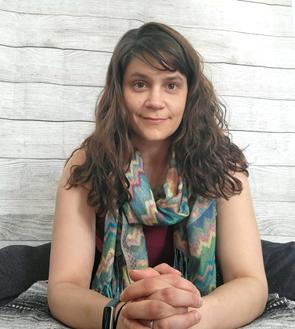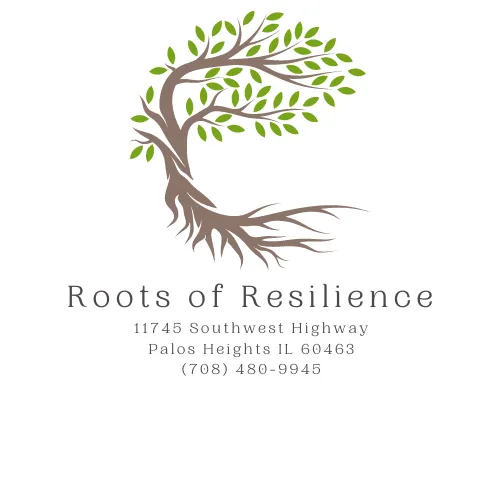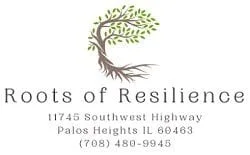Looking To Broaden Your Self-Care Practice To Manage Stress & Anxiety?

Welcome to our blog series highlighting alternative practices and approaches to self-care! Maybe you are in need of some additional self-care tools to manage stress & anxiety or interested in a new way to connect with your mind, body, spirit and nature. Our first guest is Stephanie Seals, Yoga & Meditation Teacher from Yogic Path 2 Wellness. Stephanie is a Licensed Clinical Social Worker working as a psychotherapist while completing her yoga therapist training.

How did you begin your own yoga and meditation practice?
I started getting interested in Buddhism around age 15, which led to reading about meditation. Around the same time, my parents had some VHS yoga tapes that I’d do in the family room. It wasn’t until 2008 when I moved to Chicago for my Master’s in Social Work program that I started going to a yoga class at a studio every week. I’ve dipped in and out with the consistency of my practice over the years, but I always find myself being drawn back to it. I finally decided to take yoga teacher training in 2019, and completed a meditation teacher training shortly thereafter. I just keep realizing there’s more to learn, so I keep going!
What drew you to the practice of yoga?
I took ballet as a kid, which was an incredible physical and expressive outlet for me for a long time. After some injuries–and disillusionment with what I perceived as a competitive nature in the dance world–I came back to yoga. I noticed similarities to dance in terms of the attention to posture and form, the lines and shapes made with the physical body, and finding some relief from anxious thoughts by giving my mind something to focus on. And if I’m being totally honest - what really kept me coming back to yoga week after week, was how quickly I noticed improvements in my balance, strength, and general skills in such a short amount of time.
How can meditation help to calm anxious thoughts and feelings?
I feel like this is a bit of a trick question, because sometimes meditation can make a person feel really unsafe…especially those folks with trauma history and a lot of dissociation. (If that’s your experience, please seek assistance from a skilled meditation teacher and/or psychotherapist.) The point of meditating is not necessarily to feel amazing. It’s to learn how to sit with the discomfort of your thoughts, to separate from them, and teach your nervous system that you’re okay. Once we learn to observe our thoughts and feelings, we see that they come and go, and that underneath a steady presence remains: Self.
How does yoga help those feeling anxious to gain a sense of calm?
Yoga consists of 8 limbs, and just one of those limbs refers to the physical practice (poses or asana) that we call yoga in the west. Yoga postures are usually sequenced very carefully with a lot of attention to their effects on the body AND nervous system. In yoga philosophy, there’s this concept of sukha (ease) and sthira (effort/stability) that we’re always trying to balance. The classes that I teach typically pendulate (move back and forth between) effort and ease in a way that pushes a person towards their edge, and then allows them to relax and reconnect with safety. This is a lot of what trauma therapists do to help clients expand their “window of tolerance.”
If you start to study more of the philosophy behind the yoga poses, you will likely have more connection to practices off the mat. For example, even though I don’t do yoga poses everyday, I’m still applying principles of yoga philosophy to my daily life. I’m mindful enough to (sometimes) be able to notice when I’m experiencing discomfort, and I am able to breathe or use mantra to find some ease in the present moment.
Have you found that yoga and meditation can be beneficial for more than just those seeking relief from stress and anxiety?
I think yoga and meditation can benefit potentially anyone, if they are open to it. As a yoga therapist in training, I have studied how to apply techniques from the 8 limbs of yoga to help people suffering from trauma, depression, chronic pain, chronic illness, heart disease, the effects of cancer treatment, traumatic brain injury, and more. I’m in recovery from substance use disorder, and twelve step programs didn’t really work for me. What helped immensely was reconnecting with my yoga practice.
What can one expect in attending their first yoga class with you?
It depends on which class they sign up for! Sometimes my classes are hatha (holding poses statically), vinyasa (more flow), beginner, basics, or even all-levels candlelight yoga with meditation. And a therapeutic yoga class would look quite different - it would be much slower paced and more focused on the subtleties of breath, movement, emotions, thoughts, intuition, etc. Regardless of which class someone attends with me, I’d want them to know that they are the expert about their own body and lived experience, and anything I might teach or offer is just a suggestion. Yoga is a time to explore, hold lightly, and maybe even chuckle.
Any advice for those hesitant to try the practice of yoga?
Yoga is for everybody. It’s not about how you look, what you wear, or what poses you can do. If you can consciously control your breath or observe your mind, you can do yoga. If it feels more comfortable to dabble at home, check out some books from the library or watch some videos on YouTube. When you’re ready to go to a class, try someplace that won’t intimidate you - maybe your local rec center or a studio that has great reviews about being down-to-earth and welcoming to all.
What is your best advice for those wanting to begin a meditative practice, but don’t know where to begin?
There are so many different ways to meditate - just pick something and give it a go. If it doesn’t speak to you, switch it up or try it again later. Apps are a great way to sample the various types of meditation. My favorite is Insight Timer, which has free and paid options. Start small - maybe you sit for 3 minutes at a time - then work your way up to longer periods of time. I always find it helpful to sit in a room and meditate with others. If you want to try on your own and have no experience whatsoever, I have a recorded training available at my website. It consists of 4 recordings (45 minutes each) that are meant to be viewed over the course of 4 weeks, with some handouts and homework in between. It covers meditation basics as well as a few types of meditation (mantra, tradak, etc.) from a yogic perspective. Interested folks can get 20% off by using the coupon code ROOTS20.
The best way to reach me is via email: [email protected]
Offerings will always be on my website: www.yogicpath2wellness.com
And I will continue posting content on instagram: @findyourpath2
More About Stephanie Seals
Stephanie started learning about Buddhist philosophy and meditation practices as a teenager. Stephanie initially sought yoga as a way to continue expression through movement, after studying ballet throughout much of childhood. She began consistently attending yoga classes while working through her master's program in social work.
As she increasingly noticed the physical and mental health benefits of a regular yoga practice, she became determined to help others find their "way home" by connecting mind, body, and spirit. This led her to a 200 hour yoga teacher training with Chi-Town Shakti Yoga + Meditation, completed in 2020.
Stephanie is a partner, parent, and psychotherapist specializing in helping people impacted by trauma and addictions. She is currently completing a 1,000 hour IAYT accredited yoga therapy program.

Welcome to our blog series highlighting alternative practices and approaches to self-care! Maybe you are in need of some additional self-care tools to manage stress & anxiety or interested in a new way to connect with your mind, body, spirit and nature. Our first guest is Stephanie Seals, Yoga & Meditation Teacher from Yogic Path 2 Wellness. Stephanie is a Licensed Clinical Social Worker working as a psychotherapist while completing her yoga therapist training.

How did you begin your own yoga and meditation practice?
I started getting interested in Buddhism around age 15, which led to reading about meditation. Around the same time, my parents had some VHS yoga tapes that I’d do in the family room. It wasn’t until 2008 when I moved to Chicago for my Master’s in Social Work program that I started going to a yoga class at a studio every week. I’ve dipped in and out with the consistency of my practice over the years, but I always find myself being drawn back to it. I finally decided to take yoga teacher training in 2019, and completed a meditation teacher training shortly thereafter. I just keep realizing there’s more to learn, so I keep going!
What drew you to the practice of yoga?
I took ballet as a kid, which was an incredible physical and expressive outlet for me for a long time. After some injuries–and disillusionment with what I perceived as a competitive nature in the dance world–I came back to yoga. I noticed similarities to dance in terms of the attention to posture and form, the lines and shapes made with the physical body, and finding some relief from anxious thoughts by giving my mind something to focus on. And if I’m being totally honest - what really kept me coming back to yoga week after week, was how quickly I noticed improvements in my balance, strength, and general skills in such a short amount of time.
How can meditation help to calm anxious thoughts and feelings?
I feel like this is a bit of a trick question, because sometimes meditation can make a person feel really unsafe…especially those folks with trauma history and a lot of dissociation. (If that’s your experience, please seek assistance from a skilled meditation teacher and/or psychotherapist.) The point of meditating is not necessarily to feel amazing. It’s to learn how to sit with the discomfort of your thoughts, to separate from them, and teach your nervous system that you’re okay. Once we learn to observe our thoughts and feelings, we see that they come and go, and that underneath a steady presence remains: Self.
How does yoga help those feeling anxious to gain a sense of calm?
Yoga consists of 8 limbs, and just one of those limbs refers to the physical practice (poses or asana) that we call yoga in the west. Yoga postures are usually sequenced very carefully with a lot of attention to their effects on the body AND nervous system. In yoga philosophy, there’s this concept of sukha (ease) and sthira (effort/stability) that we’re always trying to balance. The classes that I teach typically pendulate (move back and forth between) effort and ease in a way that pushes a person towards their edge, and then allows them to relax and reconnect with safety. This is a lot of what trauma therapists do to help clients expand their “window of tolerance.”
If you start to study more of the philosophy behind the yoga poses, you will likely have more connection to practices off the mat. For example, even though I don’t do yoga poses everyday, I’m still applying principles of yoga philosophy to my daily life. I’m mindful enough to (sometimes) be able to notice when I’m experiencing discomfort, and I am able to breathe or use mantra to find some ease in the present moment.
Have you found that yoga and meditation can be beneficial for more than just those seeking relief from stress and anxiety?
I think yoga and meditation can benefit potentially anyone, if they are open to it. As a yoga therapist in training, I have studied how to apply techniques from the 8 limbs of yoga to help people suffering from trauma, depression, chronic pain, chronic illness, heart disease, the effects of cancer treatment, traumatic brain injury, and more. I’m in recovery from substance use disorder, and twelve step programs didn’t really work for me. What helped immensely was reconnecting with my yoga practice.
What can one expect in attending their first yoga class with you?
It depends on which class they sign up for! Sometimes my classes are hatha (holding poses statically), vinyasa (more flow), beginner, basics, or even all-levels candlelight yoga with meditation. And a therapeutic yoga class would look quite different - it would be much slower paced and more focused on the subtleties of breath, movement, emotions, thoughts, intuition, etc. Regardless of which class someone attends with me, I’d want them to know that they are the expert about their own body and lived experience, and anything I might teach or offer is just a suggestion. Yoga is a time to explore, hold lightly, and maybe even chuckle.
Any advice for those hesitant to try the practice of yoga?
Yoga is for everybody. It’s not about how you look, what you wear, or what poses you can do. If you can consciously control your breath or observe your mind, you can do yoga. If it feels more comfortable to dabble at home, check out some books from the library or watch some videos on YouTube. When you’re ready to go to a class, try someplace that won’t intimidate you - maybe your local rec center or a studio that has great reviews about being down-to-earth and welcoming to all.
What is your best advice for those wanting to begin a meditative practice, but don’t know where to begin?
There are so many different ways to meditate - just pick something and give it a go. If it doesn’t speak to you, switch it up or try it again later. Apps are a great way to sample the various types of meditation. My favorite is Insight Timer, which has free and paid options. Start small - maybe you sit for 3 minutes at a time - then work your way up to longer periods of time. I always find it helpful to sit in a room and meditate with others. If you want to try on your own and have no experience whatsoever, I have a recorded training available at my website. It consists of 4 recordings (45 minutes each) that are meant to be viewed over the course of 4 weeks, with some handouts and homework in between. It covers meditation basics as well as a few types of meditation (mantra, tradak, etc.) from a yogic perspective. Interested folks can get 20% off by using the coupon code ROOTS20.
The best way to reach me is via email: [email protected]
Offerings will always be on my website: www.yogicpath2wellness.com
And I will continue posting content on instagram: @findyourpath2
More About Stephanie Seals
Stephanie started learning about Buddhist philosophy and meditation practices as a teenager. Stephanie initially sought yoga as a way to continue expression through movement, after studying ballet throughout much of childhood. She began consistently attending yoga classes while working through her master's program in social work.
As she increasingly noticed the physical and mental health benefits of a regular yoga practice, she became determined to help others find their "way home" by connecting mind, body, and spirit. This led her to a 200 hour yoga teacher training with Chi-Town Shakti Yoga + Meditation, completed in 2020.
Stephanie is a partner, parent, and psychotherapist specializing in helping people impacted by trauma and addictions. She is currently completing a 1,000 hour IAYT accredited yoga therapy program.



